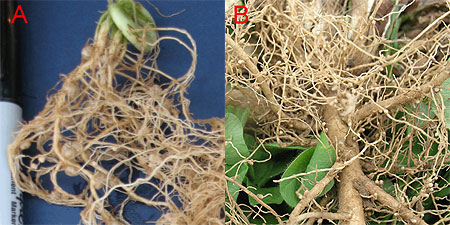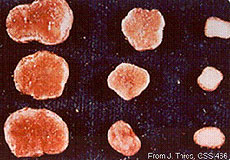Legume nitrogen fixation learning module
The basics of legume N fixation
Biological N fixation is a process carried out by specific microbes that have the ability to convert atmospheric N2 gas into forms that can be used by plants. The most important type of BNF for agriculture is referred to as symbiotic N fixation. Symbiotic N fixation involves a partnership between plants and the microbes that are able to carry out this chemical reaction. Legumes are the most prominent group of N-fixing plants.
Although our atmosphere is 78% N2 gas, N is often the most limiting nutrient for plant growth because plants lack enzymes that can convert it into a usable form. As a result, most plants in nature rely on the N released from microbial decomposition of soil organic matter. Legumes are unique because they have evolved a symbiosis with specialized bacteria that produce enzymes to “fix” N2 gas into amino acids within specialized root structures called nodules, making the N available for plant growth. In exchange for fixed N, the plant provides energy in the form of carbon substrates (i.e. sugars) and protection to the bacteria in the root nodules.

Larger image
Figure 1. Nodulated roots of: A) soybean grown in the greenhouse; and B) red clover grown in the field.

Figure 2. Cross-section of soybean nodules with differing concentrations of leghemoglobin. Active nodule color can range from blood red to a very pale pink. |
One quick check to see if nodules are actively fixing N is to break open the nodule to see if the flesh is pink inside. The pink color is from leghemoglobin, a protein that carries oxygen—similar to the hemoglobin in human blood. The nitrogenase enzyme involved in N fixation is sensitive to oxygen and the leghemoglobin helps reduce oxygen concentrations in the area of the nodule where the nitrogenase enzyme is active.
How does soil fertility affect N fixation? Go to the next unit:
The effects of soil fertility on legume N fixation
© Copyright, Department of Horticulture, Cornell University.
Logo graphics by Rachel Kennedy.
Design by Craig Cramer.
Mention of trade names and commercial products is for educational purposes; no discrimination is intended and no endorsement by Cornell Cooperative Extension or Cornell University is implied. Pesticide recommendations are for informational purposes only and manufacturers' recommendations change. Read the manufacturers' instructions carefully before use. Cornell Cooperative Extension and Cornell University assumes no responsibility for the use of any pesticide or chemicals. Some of the links provided are not maintained by Cornell Cooperative Extension and Cornell University. Cornell Cooperative Extension and Cornell University are not responsible for information on these websites. They are included for information purposes only and no endorsement by Cornell Cooperative Extension or Cornell University is implied. Cornell Cooperative Extension provides equal program and employment opportunities.